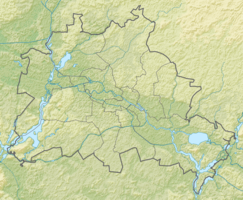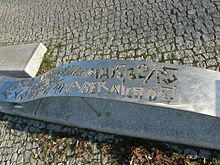Regine Hildebrandt Park
| Regine Hildebrandt Park | ||
|---|---|---|
| Park in Berlin | ||

|
||
| Regine-Hildebrandt-Park from Riesaer Straße, in the foreground the barrier-free staircase | ||
| Basic data | ||
| place | Berlin | |
| District | Hellersdorf | |
| Created | 2007 (opening of the first construction phase) | |
| Newly designed | 2008, 2009, 2010 (further construction phases) | |
| Surrounding streets |
Riesaer Strasse, Mylauer Strasse, Boulevard Kastanienallee |
|
| Buildings | Staircase, stainless steel bridge, "construction kit", "house harvest wreath" | |
| use | ||
| Park design | Landscape architect Gabriele Wilheim-Stemberger (planning and construction management) | |
| Technical specifications | ||
| Parking area | 26,800 m² | |
|
52 ° 32 '6.4 " N , 13 ° 36' 13.1" E
|
||
The Regine-Hildebrandt-Park is an urban park in the Berlin district of Hellersdorf , Marzahn-Hellersdorf district , which was named after the Brandenburg politician Regine Hildebrandt when it was opened in 2007 . It covers an area of 26,800 square meters and is delimited by the subway line to Hönow, Riesaer Straße, Mylauer Weg and the Kastanienallee boulevard. After the first expansion phase, further parts were completed and handed over to the public by 2010.
history
Immediately after the political turnaround , the expansion into a district park was planned on the area of the Hellersdorfer Graben along the underground line . It should be created by the investor group MEGA as a compensation and replacement measure for granted building permits in what was then the Hellersdorf district. However, the group went bankrupt , so nothing happened for several years. Thanks to the strong commitment of the Marzahn-Hellersdorfer City Planning Office, with a sum of 1.175 million euros from the Senate's Urban Redevelopment East for a first construction phase, as well as a further investment volume of 176,000 euros from the STERN Society for Careful Urban Renewal, the first section shown in the picture was completed.
On June 21, 2007, the park was handed over to the public and named after the popular Brandenburg Minister of Labor and Social Affairs, Regine Hildebrandt. The state secretary for urban development, Hella Dunger-Löper , the vice-president of the Bundestag, Petra Pau , the district mayor Dagmar Pohle , the daughter of Regine Hildebrandt, Elske Hildebrandt , the district councilor for ecological urban development, Norbert Lüdtke and numerous other guests took part in the inauguration ceremony part.
Between autumn 2007 and the end of 2009, additional park design measures - also based on plans by Gabriele Wilheim-Sternberger - were carried out in further construction phases with funds from compensatory and replacement measures for a Deutsche Bahn construction project amounting to around one million euros. This included, above all, the installation of a step footbridge made of stainless steel to cross the Hellersdorf trench. Their execution had been delayed by several months due to the temporary shortage of steel on the world market. In the end, however, the "green belt" was closed to the Cottbusser Platz underground station . The completed footbridge also finds critics who describe it as "too bulky" or even as "disfigurement" or a waste of money.
On April 11, 2010, the area east of Riesaer Strasse and northwest of the Heidenauer Strasse - Sebnitzer Strasse street was removed from the planned expansion of the Regine-Hildebrandt-Park. In a ceremony it was given the independent name Kurt-Julius-Goldstein-Park , named after the anti-fascist and survivor of Auschwitz, Kurt Julius Goldstein . Funds from the later construction phases were used for this purpose.
Park description
overview
At a width of almost 100 meters south of the underground line and a length of about 270 meters between the Kastanienallee boulevard and Riesaer Straße, a small, unkempt and already existing green corridor at Hellersdorfer Graben has been redesigned into a park that overhangs to the west and east Stairs is accessible. The eastern staircase was designed around 50 meters wide and absorbs the slope of 5 meters with three larger steps, a diagonally oriented ramp path and interesting design elements on the stairs. The "construction kit" directly on the bridge and the "Haus Erntekranz" of the disabled assistance (Tiele-Winckler-Haus GmbH) on the stairs to the Boulevard Kastanienallee were included in the design as striking structures.

The lower parking area was laid out parallel to the Hellersdorfer Graben along a central avenue of trees. It is divided into different areas, which include a quiet zone with lawn and bush maze, an adventure zone with oversized metal bulrushes on swaying stems, a forest of poles with stainless steel metal bands in between and a huge stainless steel tub, rose plantings and other things.
In total, over 140 trees had been planted in this park by the end of 2008. Some design elements are repeatedly damaged by graffiti, sometimes with right-wing extremist content.
Eastern stairs
Before there was no access to the park from the upper street level, 13 oaks had been planted instead. The new wide staircase itself contains some freshly planted trees; the oaks were moved. On the way down (or up) the visitor encounters some stainless steel metal bands that are blown there and contain mysterious words. Punched out and wildly tumbling letters each form a loose saying, as it could come from Regine Hildebrandt. You have to linger a little longer, for example, to read the sentence “Consistently or inconsistently but not ewije fluctuations” from this representation (right picture).
West stair area
There are a few steps directly to the Kastanienallee boulevard. To the south, a two-part staircase to Mylauer Weg with a balcony-like middle section was built from "Haus Erntedank", from which you can overlook the park area. Both stairs are not barrier-free. The material and arrangement are based on the elements of the eastern staircase.
The stairs on the Kastanienallee boulevard and those on Mylauer Straße were financed with funds from the Living Environment Improvement Program.
Lower experience area
This begins on the east side with a square bar on which a heartfelt wish from Regine Hildebrandt (and most of the citizens of this country) is mounted vertically on each side in four languages: “May there be peace on earth.” This is followed by a circle of artificial cattails , a seating area around the water basin, the banner bar forest, a lawn, hedges as a "vegetative labyrinth" and a children's playground.
The paths required for the care and maintenance of the park and the ditch are included in the path system. The resulting surface water is seeped away via a trough infiltration system. Overall, the Regine-Hildebrandt-Park forms a self-contained concept of different experience spaces for different user groups.
Web links
Individual evidence
- ^ Speech by Petra Pau when naming the park on her own website
- ↑ a b c Handover of the Regine Hildebrandt Park to the public. Press release from June 22, 2007; BA Marzahn Hellersdorf , accessed on January 15, 2012
- ↑ Claudia Fuchs: Park is named after Regine Hildebrandt. In: Berliner Zeitung , June 20, 2007; Retrieved January 16, 2012
- ↑ Completion of Regine Hildebrandt Park is delayed. In: Berliner Morgenpost , August 28, 2008; Retrieved January 17, 2012
- ↑ a b c Regine-Hildebrandt-Park on stadtumbau.berlin , accessed on January 15, 2012
- ↑ Barbara Staacke: Too much concrete, too massive. Pedestrian bridge spans the Regine-Hildebrandt-Park in Marzahn-Hellersdorf. In: Neues Deutschland , December 2, 2009; Retrieved January 17, 2012.
- ↑ The second construction phase in the Helle Mitte district park is named after Kurt Julius Goldstein ; Press release of the Marzahn-Hellersdorf district office of April 8, 2010 , accessed on January 17, 2012.
- ↑ Website for the “Baukasten” learning center on Riesaer Strasse / Hellersdorf subway , accessed on January 17, 2012
- ^ Homepage of the Diakonissenhaus / Tiele-Winckler-Haus GmbH foundation in Berlin-Hellersdorf , accessed on January 17, 2012
- ↑ On stadtentwicklung.derlin.de: Building in Regine-Hildebrandt-Park continues. , retrieved on February 6, 2016.
- ↑ Police report (PDF document; 2.55 MB): Here page 34 ( memento from January 7, 2016 in the Internet Archive ), accessed on January 16, 2012.


